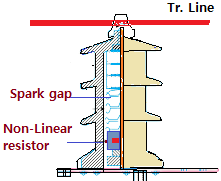I think you probably came across the question "What are Valve-Type Lightning Arresters?"
Then read the content fully for more information.
First, understand What is lightning arrestor?
Lightning arrestor- (Protective device's) Function is to divert surge voltage into the earth.
Now, the topic will become easier to understand.
The valve-type lightning arrester is also a protection device used to protect high-voltage rated equipment (above 33KV) against surge voltage, high transient voltage, and lightning strikes. High voltage equipment such as overhead power lines and the transformer needs efficient protection against electrical faults.
The operating time of the valve-type lightning arrester is less than one second (1s). The impulse ratio of a valve type arrestor lies in the range of unity. Operating time also satisfies the fundamental requirement of a protective device.
The impulse ratio is defined as the spark voltage to the power frequency voltage.
Spark voltage - voltage produced due to breakdown voltage in the spark gap.
Power frequency voltage: Voltage at the rated frequency with respect to time.
Circuit of valve type lightning arrestor
Construction of Valve type lightning arrester
- Current terminals
- Spark gap with grading resistor
- Non-linear resistor
- Porcelain housing.
Valve-type lightning arrestor embodies complete enclosure in a porcelain insulating material. This acts as insulating housing and provides mechanical strength. This protective system consists of the current terminal to which incoming and outgoing circuits are connected.
Valve type lightning arresters are fitted with a spark gap stack with grading resistors consisting of various conducting electrodes which are held at a distance by an insulating medium such as air. These spark gaps are connected in series to the non-linear resistor discs.
Functions of Major parts
The four important components in valve-type lightning arresters can be classified into Interior Components and Exterior components.
- Porcelain Housing, and
- Current terminals
Interior components of valve type LA
Interior components are inner parts of the lightning arrestor
- Non-linear resistor, and
- Spark gap with grading resistor
Non-Linear Resistors Disc in valve type arrestor
Basically, there are two types of resistors Linear Resistor and Non-Linear resistor. Non-Linear resistors are extensively used in valve-type lightning arresters because of their operating characteristics.
Non-linear resistors are made up of semiconducting components such as silicon carbide (thyrite element, or metros element). Valve-type lightning arresters are also known as thyrite arresters or non-linear arresters.
Non-linear resistors do not depend upon Ohm's Law as well as it depends upon applied voltage and temperature. In simple Non-linear resistors is a voltage-dependent resistor.
Function
Non-linear resistors offer high reactance under normal operating voltage. That means the Lightning arrester does not divert the normal operating voltage.
In this case, the non-linear resistors offer very low resistance when break-down voltage flows. It means Valve-type arresters operate only at the time of the electrical fault.
Spark Gap in valve type arrester
The gap between two or more conducting electrodes is called a spark gap.
The grading resistors are helpful in the process of linearizing the breakdown voltage.
Function
Spark gaps are designed to produce a spark or arc in between the gap during the flow of break down voltage.
Exterior components of valve type LA
Exterior components are the outermost parts of the Valve type arrester. They are
Porcelain Housing for Valve type LA
The housing of valve type LA protects the interior components against abnormal conditions of the environment. The porcelain housing provides mechanical strength to the lightning arrester.
The housing of valve type LA is made up of insulating material named "porcelain". The porcelain has the property of high resistivity, so it does not allow the high voltage to pass on the body of the device.
Function
Current terminal for valve type LA
The current terminal is the primary part of valve type LA. The terminal of the lightning arresters is designed suitably to connect it with an equipment circuit that needs protection.
Current terminals are made up of highly conductive material such as copper, or aluminum.
Function
How the Valve type arrester work?
Valve-type lightning diverts electrical faults caused by surge voltage, breakdown voltage, into the earth. But How?
Keep in mind
At Normal operating voltage, the valve-type arrestor will not operate. Because spark gap and non-linear resistors offer very high reactance to the normal operating voltage.
But whenever surge voltage occurs, the incoming current terminals of valve type lightning arrester receive a surge voltage from the fault circuit and sent it to the spark gap. Once the surge voltage attains a break-down voltage, the spark gap produces a spark or arc in between the gaps. The grading resistors of the spark gap receive breakdown voltage and linearize the breakdown voltage to the non-linear resistor discs.
Finally, Non-linear resistors offer very low resistance to this high voltage surge and efficiently diverts this surge voltage to the outgoing current terminals, where it picks up the high surge voltage and drains it to the earth.
As a result, a valve-type lightning arrester diverts the surge voltage into the earth thus preventing the failure of high voltage equipment such as power transformers, power lines, or an electrical motor.
Advantage of valve type lightning arrester
- This lightning arrester operates only at the time of high surge voltage. This will not divert the normal operating voltage.
- This has the ability to protect high-voltage-rated equipment (up to 220 Kv) in an efficient manner.
- It always maintains the impulse ratio at unity
- This valve-type arrester takes only less time to operate which is less than 1 sec.
Dis-advantage of Valve type lightning arrester
- This type of lightning arrestor does not suitable for very steep fronted waveforms.
- It can be used only in tight enclosures such as porcelain housing because it going to use spark gap constraints for operation.
Maintenance of valve type lightning arrestor
- Periodically check the value of earth resistance. It should be below 2 ohms.
- Clean the dust particles from the porcelain housing or enclosure.
- De-energize the transmission line while servicing.
Conclusion
A valve-type lightning arrester is the best protective device for protecting high voltage equipment from surge voltage.
This valve-type arrestor just going to divert the surge voltage into the earth. This arrestor is best suitable for a power station rated 220KV, as well as a substation, rated 66KV.
With the unity impulse ratio and offers protection for high-voltage equipment, engineers can't afford to ignore it.
This lightning arrestor also meets the fundamental requirements of the protective device.
Did you found anything interesting in valve-type lightning arresters?







Very Great Post. It's Really Very Informative . After All I’ll Be Subscribing On Your Feed And I Am Hoping You Write Again Very Soon.and If You Need More Information About That You Can Check Out My Page Also
ReplyDeleteVery Great Post. It's Really Very Informative . After All I’ll Be Subscribing On Your Feed And I Am Hoping You Write Again Very Soon.and If You Need More Information About That You Can Check Out My Page Also
ReplyDelete